Colchester City Centre Masterplan SPD
(6) 01 Setting the Scene
 City Centre Profile
City Centre Profile
Camulodunum, Roman Colchester, was Britain’s first recorded settlement and later Britain’s first city and capital. Colchester regained its city status in 2022 to mark Queen Elizabeth II’s Platinum Jubilee - so it is both the oldest and one of the newest cities in the UK.
Colchester is one of the UK’s fastest-growing places and one of the most important and diverse urban centres in the East of England, located midway between the largest UK container port and London’s third airport. It provides work for around 24,000 people who travel into Colchester from the surrounding area and is home to more than 13,000 students from more than 130 countries who study at the University of Essex’s Colchester campus, making it the UK’s most international campus university. It is also a garrison city with a long military association which has brought international communities to Colchester from Nepal, Fiji and other countries.
Colchester’s city centre
The city centre is the historic, retail, leisure and cultural heart of the community, as well as the main visitor destination for domestic and international tourism to the area. It is an important cultural hub for the East of England, and as of November 2022, the city centre is home to five Arts Council England National Portfolio Organisations - Firstsite, the Mercury Theatre, Colchester Arts Centre, Signals Media and the Colchester and Ipswich Museums Service, which is responsible for three museums in the city centre alone. It has a major tourist attraction in Colchester Castle, the largest Norman keep in Europe and constructed on the foundations of a Roman temple, and has the earliest and best preserved Roman city walls in Britain.
The city centre draws in a large number of young people and students from the wider area through schools and colleges including Colchester Sixth Form College and Colchester Institute including University Campus Colchester. New developments are bringing cutting-edge digital facilities to the city centre in the new Centre for Immersive Innovation as well as a wide range of public realm, walking and cycling improvements.

Wider strategic changes will continue to impact the city centre, and are set out in further detail on the following pages.
Success criteria
In order to ensure a positive legacy and success of the Masterplan, it is advised to have a discussion and agreement on how any monitoring and evaluation could support future tracking of change in the city centre. Potential success criteria could include:
- Increased local pride among business and residents and increase in positive external perceptions of Colchester as a destination
- Modal shift from private car use to active and public travel resulting in a decrease in vehicle movements in the city centre area
- Increased footfall to the core city centre area
- Retention and growth of businesses within the city centre area
- Increase in higher wage jobs in the city centre area
- Provision of high quality and affordable housing within the city centre, sustaining local shops and services
- Increased attendance to cultural venues and events
- Increased evening economy and sustained vibrancy of evening venues
- Increased tourism, in particular overnight stays.
Opportunities
- City status and the change in internal and external perceptions of Colchester as a result
- Historic environment resulting in attractive, compact and walkable centre ideal for the ‘experience economy’
- River as a currently untapped asset
- Tourism potential of major heritage attractions as well as cultural venues
- Arts and cultural activity and the wider creative and digital economy
- Residential neighbourhoods surrounding the city centre within an easy walk - a large potential customer / visitor base
- High numbers of students and young people living and studying in and around the city centre
- Cultural diversity of Colchester’s communities and the businesses and experiences they support
- Easy connectivity to London as well as other regional centres
- Reduction in commuting and increase in working from home, or working near home
Challenges
- Historic perceptions of Colchester both internally and externally affecting confidence and local pride
- Physical severance of neighbourhoods from the city centre by arterial roads and topography
- Poor public transport and active travel infrastructure connecting neighbourhoods to the city centre, resulting in a reliance on the private car and resulting congestion
- Changes in retail and consumer patterns nationally which are also reflected locally, in particular for the evening economy
- Competition for retail and leisure customers from edge-of-centre locations including the Northern Gateway and Stanway Tollgate, with free parking and easy car access
- Ingrained transport habits of residents in the wider city area and a reluctance to adopt modal shift to active and public transport
- Tightly-knit historic street pattern creating conflicts between pedestrian, cyclists and business delivery and servicing needs
- Funding, viability and delivery of projects in a complex and constrained city centre including substantial archaeological and below ground constraints
- Climate change impacts and adaptation
- Continuous recovery from the Covid-19 pandemic
Masterplan Scope and City Centre Transport Plan
The focus of the masterplan is on the core city centre area - the primary and secondary shopping area as defined in the Local Plan, as well as the main city centre development allocations and gateways to the surrounding neighbourhoods.
However, the continued economic and cultural vibrancy of the city centre lies in reconnecting it to the surrounding neighbourhoods and improving the walking and cycling experience of routes to the mainline rail station, the Roman Circus and the Hythe and University campus in particular. The masterplan therefore includes recommendations for wider area improvements with regard to connectivity and public realm.
Design frameworks have been prepared for the main city centre development allocations and gateways, which have been refered to as key sites.
The package of documents includes the City Centre Masterplan with appendicies, the City Centre Transport Plan and the Delivery Note.
City Centre Transport Plan
Steer has prepared the City Centre Transport Plan (CCTP) a key document used to frame and inform the holistic City Centre Masterplan.
The overall aim of the CCTP is to recommend a range of transport interventions that can be packaged together to take forward as part of Colchester’s city centre masterplan. The three potential packages will be tested following submission of this CCTP using the ECC Strategic Model.
The document recognises the current dominance of car travel in Colchester and the overarching need to encourage the use of sustainable modes of transport through the provision of walking, cycling, bus and train facilities to improve the city centre through reduced congestion and to improve the quality of life for local residents and visitors. The document recognises improved accessibility, connectivity and movement as key drivers for change for achieving social inclusivity. It reflects local policy drivers, the Future Transport Strategy in particular. Future proofing the city whilst protecting and enhancing cultural and historical assets is crucial to Colchester’s ambition for a safer, greener and healthier future.
This CCTP shortlists a range of transport and urban realm interventions across a range of disciplines. The interventions related to physical / tangible measures have been geographically assigned to key corridors and City Gateways across Colchester’s city centre, which were identified through a strategic assessment from a connections and accessibility perspective. This CCTP has further identified key zonal policies / measures, and service implementation / changes that cannot be linked to specific city centre geographical locations, but are equally as important for implementation to achieve the CCTP objectives.
The CCTP recommendations have been integrated into the Masterplan and are particularly reflected in the following masterplan layers and accommpanying urban design strategies: Actively Respond to the Climate Emergency, Provide a Health, Safe, Active and Accessible City Centre and Support the City Centre Economy for Everyone’s Benefit.
Delivery Note
A separate delivery strategy for Colchester Borough Council and Essex County Council has been developed that outlines partnership, financing and delivery structures, as well as the actions / process required to implement the initiatives contained in the masterplan.

Strategic Context
This masterplan builds on the vision and objectives for the city centre set out in the Local Plan as well as other strategies and policies developed by Colchester City Council and partners. It reflects work already being delivered through the Town Deal, the Active Travel Fund and other initiatives and funding sources, as well as priorities put forward as part of Colchester’s Levelling Up Fund bid in 2022.
Planning policy context
The Colchester Borough Local Plan 2017 – 2033 Section 2 was adopted in July 2022. The vision for Colchester in 2033 is set out as:
‘Colchester will be an active and welcoming town with its rich and prestigious heritage treasured and showcased for all to enjoy. Colchester will be acclaimed for the creative, innovative and sustainable ways in which it addresses the wide range of challenges facing the Borough, including climate change; population growth and its changing composition; new lifestyle and technological innovations; creating and maintaining strong safe, healthy communities; and shifting market forces.’
The vision also considers the city centre:
The Council will work proactively to ensure that the historic Town Centre continues its role as the cultural and economic heart of the Borough and international visitor destination.
The Local Plan objective ‘Supporting the Town Centre as the Heart of the Borough’ acknowledges that the city centre serves as a centre not only for the Borough but for a much wider area of North East Essex and has an important role as a heritage, retail and business destination. It “seeks to retain the pre-eminence and vitality of the Town Centre in the face of changing economic and lifestyle trends and the rapid pace of technological innovation.”
The Local Plan sets out a number of strategic growth areas around the city centre as well as development site allocations within the city centre itself. In total, the Local Plan seeks to deliver at least 920 new homes per year over the Plan period, with most of this growth focused in and around the city. Key strategic sites include the Tendring Colchester Borders Garden Community (TCBGC) which will add 7000 to 9000 homes over the next 20 years. TCBGC will be connected with the rest of the city by the Rapid Transit System whose design and delivery has been enabled by HIF funding. Both the TCBGC and Middlewick Area are anticipated to start delivering housing growth in the next 10 years, whilst the substantial delivery of the TCBGC will go beyond 10 years and is anticipated to deliver from 2025/26. Other sites such as the Garrison Regeneration Area are already largely built out and remaining development will likely be completed in the next five years.

1. Town Centre and North Station Regeneration Area
2. Tendring Colchester Borders Garden Community
3. University and Knowledge Gateway Area
4. Middlewick Area
5. Garrison Regeneration Area (remaining sites to be
delivered are the ABRO site and Arena site)
6. Northern Gateway
Alongside this, locations are identified for additional business floorspace, which are also focused in and around the city, primarily at North Colchester and the Knowledge Gateway but including some floorspace within the city centre core itself.
With regard to the city centre, the Local Plan recognises that “Colchester Town Centre is the principal comparison goods shopping destination in the
Borough supported by a number of non-retail facilities including services, leisure, cultural, and community uses. Research and analysis has established that the Town Centre is relatively healthy, although there are areas of weakness and concerns over longer term investment prospects. New retail and leisure development in particular is necessary to ensure the Town Centre’s vitality and viability over the plan period.” The Local Plan sets out a robust ‘town centre first’ approach to help protect the city centre against competition from other shopping destinations.
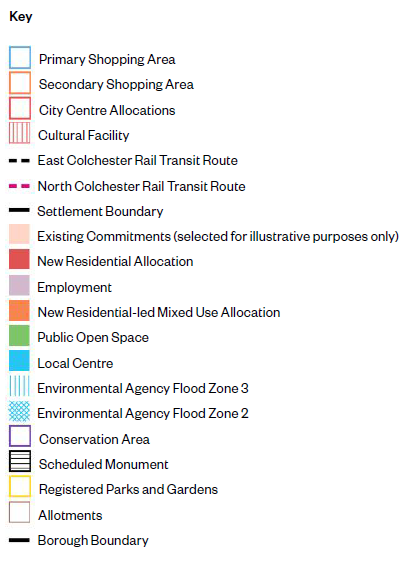
.jpg)
Policies TC1 and TC2 for the city centre are intended to encourage a greater diversity of city centre uses to provide a more robust economic environment including more evening activities. They also look for opportunities to enhance the public realm and the attractiveness of the street environment. Spatial definition is given on the policies map for the TC1 policy area as well as a Primary Shopping Area and Primary and Secondary Street Frontages given protection under policy TC2.
Policy TC3 sets out site allocations for additional residential and mixed use floorspace at Vineyard Gate; St Botolph’s; Priory Walk; Britannia Car Park and part of St Runwalds Car Park. The Plan expects 290 new homes to be delivered on these sites during the Plan period. ‘Windfall’ (unallocated) housing development in the city centre is also anticipated through redevelopment of other small sites.
Policy TC4 sets out the transport policy position for the city centre and desired improvements including enhancements to Southway and St Botolph’s Roundabout; improvements to public transport and the walking and cycling network generally within the city centre; and the provision of space for the Rapid Transit system.
Other relevant plans and strategies
The development of the masterplan has been informed by a wide range of other plans and strategies including and not limited to the following:
- Essex Local Transport Plan and Essex Transport Strategy
- Economic Plan for Essex and North Essex Economic Strategy
- Colchester Borough Council Strategic Plan, Economic Strategy, Encironmental Sustainabilty Strategy, Cultural Strategy, Positive Parking Strategy, Parking Estate Plan
- Essex County Council’s Colchester Future Transport Strategy, Local Cycling and Walking Infrastructure Plan (LCWIP)
- Our Colchester BID’s Leisure Recovery Strategy, Indies Vision
Colchester City Council was one of the first in the UK to declare a climate emergency, acknowledging urgent action is needed to limit the environmental, social and ecnomic impacts of climate change and to committing to net zero carbon emissions by 2030.
Town Deal and Levelling Up Funds
The city was also awarded £18.2m of Town Deal funding in March 2021 which will enable a number of projects: developing the former Essex County Hospital for housing, delivering a number of public realm improvement projects in the city centre, restoring Holy Trinity Church and churchyard, starting the restoration of the Balkerne Tower (Jumbo), improving community facilities in the Greenstead area, improving walking and cycling links between the city centre, Greenstead and the university and speeding up the introduction of 5G infrastructure.

Masterplanning Process
The process of developing the masterplan began with reviewing existing policy and guidance, most importantly the Colchester Borough Local Plan 2017 – 2033 Section 2 and Better Colchester Strategic Plan 2020-2023.
A thorough baseline appraisal followed - the findings of this analysis are summarised on the following pages.
The policy review and baseline analysis resulted in identifying five masterplan objectives:
- Actively respond to the climate emergency
- Provide a safe, healthy, active and accessible city centre
- Diversify city centre uses to encourage footfall
- Support the city centre economy to everyone’s benefit, and
- Make the most of Colchester’s unique heritage.
The Masterplan has been structured around these five objectives, and the masterplan layers delivering against each objective are represented as high level spatial strategies.
At the next level of detail, each objective has been broken down into two themes and urban design strategies for each theme have been developed. These are intended to guide and shape development proposals across the core city centre.
Design frameworks have been developed for the site allocated for development / redevelopment in the Local Plan, as well as key public realm corridors.
Public and stakeholder engagement was integral to the development of the Masterplan, the findings informing almost every aspect of the Masterplan.
A parallel transport study was undertaken, results of which are integrated in the masterplanning work and are also separately contained within the City Centre Transport Plan. This illustrates the complex transportation challenges the city centre faces, as well as the opportunities for significant positive impact on sustainability and quality of life that improved transportation can achieve.

Baseline Appraisal Summary
Wider Context and Uses
Key findings
- Colchester city centre is rich in heritage, visitor attractions and has a strong retail and leisure offer
- The greatest challenge at present is the fast-changing nature of the way people work, shop and spend their leisure time, spurred by the growth of e-commerce and emergence of new post-pandemic norms
- Colchester’s main train station is a 20 minute walk from the city centre, up a hill, which makes travel to the city centre challenging for those with reduced mobility
- Out-of-town shopping draws footfall and revenue away from the city centre
- The city centre’s access to green space is relatively good due to the proximity and accessibility of Castle Park; the city centre is dotted with otherwise small open and green spaces, which are often associated with historic structures such as churchyards
- Colchester has a strong and diverse arts, cultural, digital and creative sector, which includes over 3,500 businesses (10% of overall number of businesses); the strength of the cultural sector is exemplified by five Arts Council England National Portfolio Organisations.

Castle Park is one of Colchester’s a major greenspaces

Firstsite Gallery is a popular cultural and community destination


Baseline Appraisal Summary
Transport
Key findings
- Road traffic growth and significant congestion can occur during peak times on the limited number of routes in and out of the city centre
- High reliance on private car use - 58% of the population rely on a car as their method of travel to work, with 71% of the total population owning either 1 or 2 vehicles; high levels of private car use also supported by public survey results
- High volumes of traffic result in air pollution being above legal limit in city centre
- Reasonable level of cycling infrastructure, much of which is focused within the city centre itself and comprises a mixture of on and off-road routes, however these are often fragmented
- Southway is a major form of severance from areas south of the city centre
- Major planned transport improvements include Local Cycling and Walking Infrastructure Plans (LCWIP) and implementation of the Rapid Transit System which will link the city centre with new major growth area Tendring/Colchester Borders Garden Community
- A £20m funding bid has been submitted to the Government’s Levelling Up Fund (LUF) - primary focus of the bid is to improve the St Botolph’s junction to increase permeability and create better active travel links.
.png)
Colchester workers living outside the city 24,176
.png)
Colchester workers living inside the city 24,176
Source: Colchester Borough Council Factsheet, 2011

Baseline Appraisal Summary
Heritage
Key findings
- Colchester is one of the most important historic cities of England but, despite its long history is less visited than more high profile cathedral cities.
- St Botolph’s Priory, the Roman Circus and the Roman Wall are opportunities for high impact improvements to Colchester’s heritage offer.
- Better public realm and pedestrian connections to and between heritage assets can help to piece back together some of fragmented parts of the city centre and help Colchester to work as a unified whole.
Conservation areas
- City Centre
- Lexden Road, The Avenue
- Colchester - Abbey Field Conservation Area
- North Station and Environs
- Mill Field Estate
- Colchester New Town Conservation Area
Scheduled Ancient Monuments (SAM)
- Colchester Castle
- Town ditch
- SE corner of Roman town in Easthill House Gardens
- St Botolph’s Augustinian Priory
- The Benedictine Abbey of St John
- Roman Wall
- Balkerne Gate
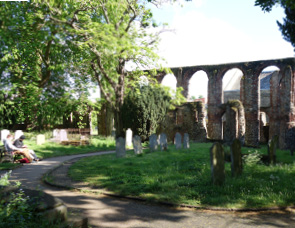
St Botolph’s Priory
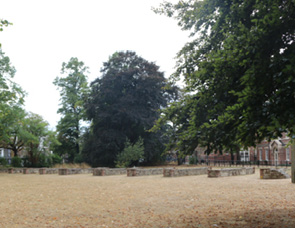
The Roman Circus

The Roman Wall

Baseline Appraisal Summary
Socio-Economic
Key findings
- Against comparators, Colchester appears to have more nightime, retail and hospitality businesses and jobs; 30% of the city centre’s jobs are in retail, hospitality, leisure and recreation - these are important for vitality but often experience low pay and poor job security
- A high proportion of those low paying jobs are concentrated in and around the city centre
- Colchester centre appears to have surprisingly high growth in families with young children—the 0 to 15 age group increased by 37% between 2011 and 2020.
- Against comparators, Colchester centre has low proportion of young adults, despite having a university in the city
- Despite a regular influx of students coming to the University of Essex, retention of young working professionals is low
- Health and disability deprivation primarily affects residents within the city centre and areas to the east/southeast.
Net internal migration in Colchester in June 2020
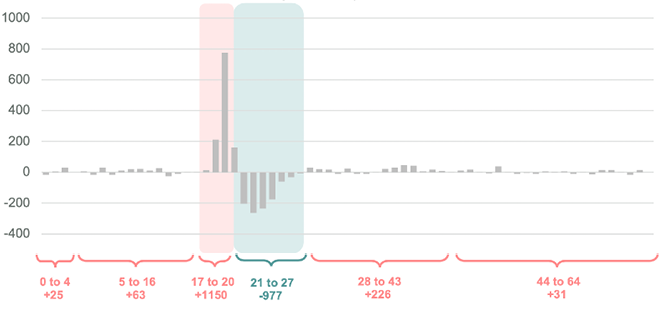
Spatial distribution of lowpaying jobs
.png)
10 year population change aged 16 - 24
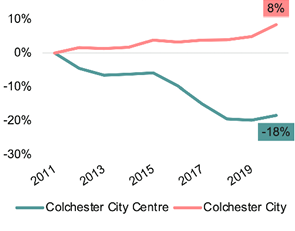
Proportion of low paying jobs in city/town centres
1.png)
Baseline Appraisal Summary
Key Findings
This spread summarises the key overarching findings from each discipline.
Wider Context and Uses
The city enjoys a rich and interconnected arts, culture and community sector.
Strong educational facilities are located in the city, including Colchester Institute and University of Essex.
Shopping centres outside of the city centre draw business and footfall away from it.
Ongoing improvements happening at various stages of delivery - Town Deal funding, the LUF bid, and RTS and LCWIP corridors.
Transport
Travel by car is the dominant mode of travel , resulting in congestion and air pollution within a large part of the core city centre and wider area.
The hilly terrain poses issues of accessibility for disabled and less able bodied people, particularly when accessing the city centre from the north and east.
While the core of the city centre is fairly pedestrian-friendly, the main roads forming the ring road are frequently congested, with poor air quality.
Heritage
Colchester has a rich and vast array of heritage assets which are currently not being capitalised on and celebrated to their full potential.
There are areas of historic interest that fall just outside of the city centre, such as East Street and East Hill and the Roman Circus, that could be better linked to the city.
Lack of connectivity across Southway severs routes to key heritage sites, such as the Roman Circus and reduces opportunities to develop the heritage offer.
Socio-Economic
30% of the city centre’s jobs are in retail, hospitality, leisure, and recreation. These are important for vitality but often experience low pay and poor job security.
Despite a regular influx of students coming to Essex University, retention of graduates is low.
A variety of new sectors have appeared in the city centre— including ‘artistic creation’, engineering consulting, residential nursing—which could be seen as positive for its resilience and diversity.
Engagement Summary
Engagement Activities
Public and stakeholder engagement was integral to the development of the Colchester City Centre Masterplan; over the course of six months, the design team ran a series of engagement events that were designed to offer opportunities for concerned parties to voice their priorities for the future of Colchester city centre at different stages of the masterplan’s development.
These engagement activities included:
Masterplan Officers Steering Group, throughout
Monthly meetings with Colchester City Council officers to present masterplan progress and key messages from engagement with officers feeding back on key development stages.
Council Members
Presenting the masterplan to Colchester City Council and Essex County Council councillors at Leadership, Members Masterplan Steering Group, All Members briefing and the Team Colchester regeneration board.
Strategic stakeholders, networks and organisations
Engaging with Our Colchester Business Improvement District (BID), Community 360, Civic Society, We Are Colchester, One Colchester Delivery Board and educational bodies, such as Colchester Institute.
Themed Co-Design Workshops
Five in-person and three online workshops related to specific themes: business, accessibility and active travel, heritage, health and wellbeing, community/residents and creative and digital. We Made That and HAT Projects joined existing group meetings including the Community360 September IAG, Local Estates Forum and Alliance Executive Group meeting.
Transport
Steer developed the City Centre Transport Plan through engaging with the Steer internal Expert Panel, three Transport Workshops with CCC and ECC officers and engagement with the BID, cycling groups and bus operators.
Youth Club consultations
Workshops with young people at youth clubs (10-18 years) and feedback from the youth workers, parents and volunteers.
One-to-one conversations with businesses
Fact finding discussions with local independent businesses, including Bill and Berts, Coda, Tymperlys, Dreams, Franklins, MM Oriental Supermarket, Church Street Tavern / Sun Inn Dedham.
Public event on the High Street, 13 August
A day-long public event was held in front of Barclays bank on the High Street where the design team engaged with more than a hundred people.
Engagement session at Holiday Fun, Firstsite, 23 August
Afternoon session as part of Firstsite’s Holiday Fun programme where We Made That and HAT Projects engaged with visitors.
Online survey
An online survey was active on the Masterplan website from 10th August to 6th October 2022 and received 1843 responses.
Engagement on the draft masterplan
The team presented the draft masterplan at an online stakeholder session, which included BID members and the Civic Society, as well as the Leadership, Members Masterplan Steering Group and Team Colchester.
Future engagement / consultation
With the planned adoption of the Masterplan as a Supplementary Planning Document, the engagement and consultation process will continue in 2023.
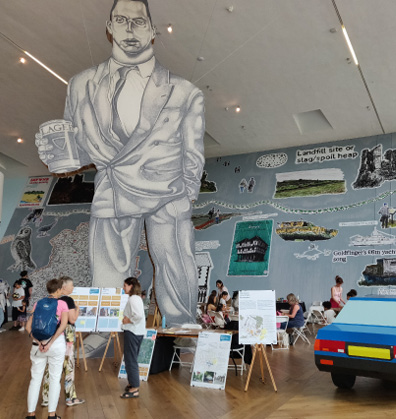
Engagement session at Holiday Fun, Firstsite

Public event on the High Street
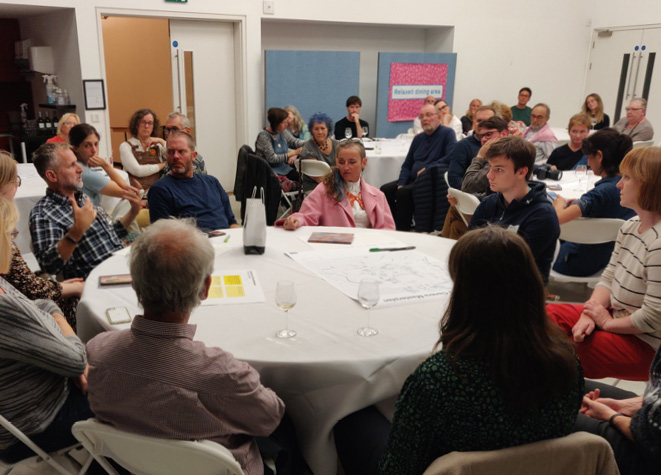
Themed workshop with the creative and digital sector

Workshop mapping and ideation
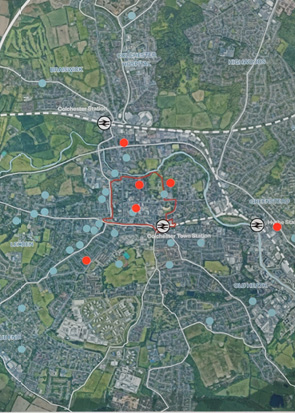
The ‘About You’ engagement board used at the public events
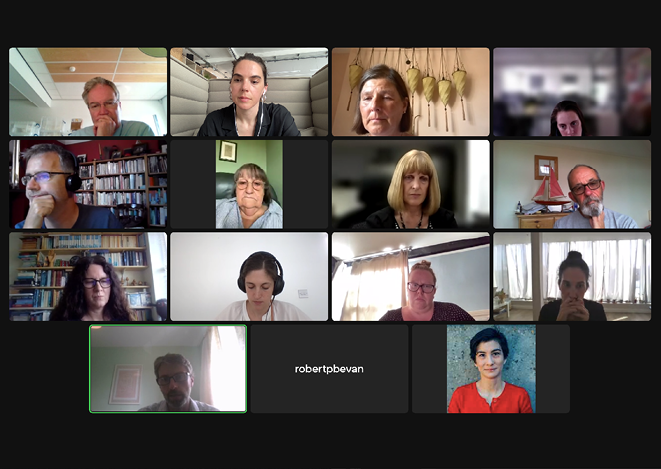
Online heritage workshop
Engagement Summary
Key Feedback and Findings
Below are some of the most commonly expressed opinions that surfaced during the engagement process.
Heritage should be a source of pride for Colchester and enhance the experience of visiting the city centre
Despite concerns about traffic and congestion, Colchester does not yet have the infrastructure to support a complete transition to public transport and active travel - there still needs to be viable parking options
Businesses would like to see increased spend/revenue in the city centre
Expand and diversify the offer of things to do in Colchester city centre
The closure of M&S and Debenhams are opportunities to introduce more local, independent businesses and community facilities
Retention of young people - offer them a good experience already when they are here as students
Accessibility and inclusivity should be an overarching and holistic goal of the Masterplan
Need for an improved pedestrianised experience and separation from cyclists/e-scooter users
What are your main reasons for visiting the city centre?
(Multiple choice question)
There is a wide range of reasons people visit Colchester city centre and this is generally consistent across all age groups. However, the response with the largest variation between age groups is “Eating and drinking out” - here, the largest percentage of people who visit the city centre for this purpose are 18-24 year olds (at 82%), while the age group with the smallest percentage of people who visit the city centre for eating and drinking out is 55-64 (52%).
Despite the fact that 82% of respondents use the city centre for non-essential shopping, qualitative responses show that respondents think the non-essential shopping offer could be improved:
“City needs so many more chains to encourage people to visit. Other than Fenwick for the high end shoppers or Primark for the lower end and younger demographic, with very little in-between.”

How do you usually travel to the city centre?

Percentage of bus users based on age:

